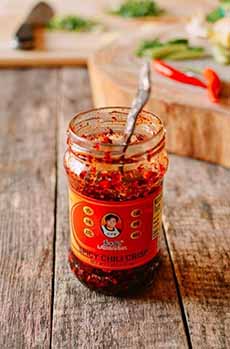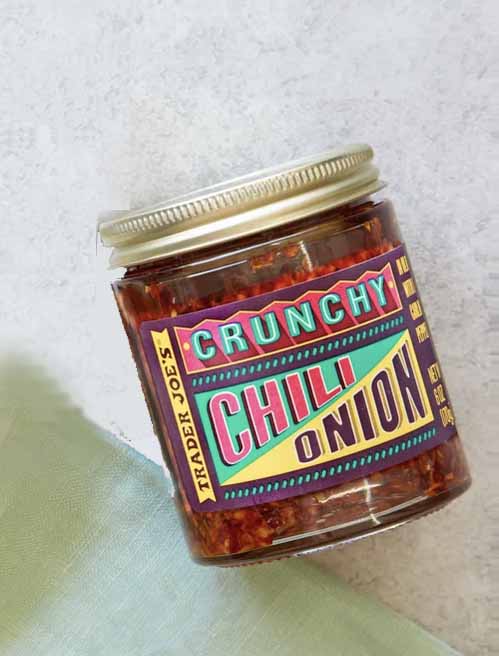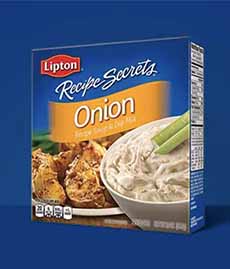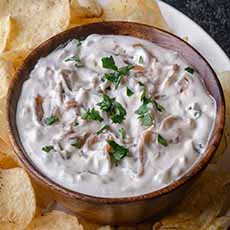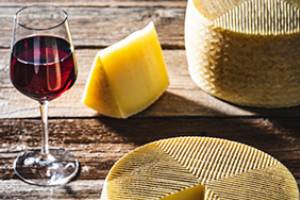Trader Joe’s Onion Dip Pasta Recipe & Spicy Chili Crisp
|
March is National Sauce Month, so how about a new idea for pasta sauce? Here’s a crowd-pleaser that doesn’t take more effort than boiling pasta and heating sauce. But this time, the sauce is made from a container of caramelized onion dip. It’s a two-ingredient recipe (photos #1 and #2) that you can enhance with the different options we list below. The “original” recipe—the exact originator of the recipe isn’t definitively known—used Trader Joe’s Caramelized Onion Dip (photo #3, but any brand will do). A quick and flavorful main course, a pasta dish sauced with a diluted container of onion dip gained popularity through social media platforms. The sour cream base of the dip, warmed and thinned, turns into a rich cream sauce with a light onion flavor. A bonus: a light crunch from the caramelized onion pieces. The recipe follows. > The different types of pasta: a photo glossary. > The history of onion dip is below. > The year’s 19 sauce, dip, and dressing holidays are below. > The year’s 20 pasta holidays. You can use any shape of pasta (photo #4) and, while the original recipe was made with Trader Joe’s, you can use any brand of caramelized onion dip. A tip for using grated cheese to garnish: Keep a wedge of Italian grating cheese in the fridge and grate it directly onto the pasta. Take your pick: 1. COOK the pasta until al dente, according to the package directions. Drain, first reserving a cup of the pasta water. Set the pasta aside. 2. ADD the onion dip to the empty pasta pot. Warm it over medium heat, stirring to smooth. Add the reserved pasta water a tablespoon at a time to thin the dip into a smooth, creamy sauce as it warms (2-3 tablespoons should do it). When the sauce is your desired consistency… 3. ADD the drained pasta back to the pot and toss to coat it with the sauce. 4. GARNISH and serve. There’s no need to heat the oven. Toast these on the stove top in five minutes or less. 1. MELT the butter in a large, heavy skillet over medium-low heat. Spread the panko in an even layer, sprinkle with the seasonings, and stir to coat the breadcrumbs. 2. WATCH the pan for 2 minutes as the crumbs toast, so you can lower the heat if it seems too hot. You don’t want to burn the breadcrumbs. As they toast and become fragrant… 3. STIR them and again spread in another even layer, continuing to stir frequently for a total of 3-4 minutes until the breadcrumbs are golden brown. 4. REMOVE from the heat. You can use them immediately, or let them cool completely and store for up to four days in an airtight container at room temperature. Spicy Chili Crisp (photo #6) is a hot, crunchy, oil-based condiment made with chili flakes; crispy bits of garlic, onion, shallots, or soybeans; and seasonings. While chili-infused oil has been used for centuries in Chinese cuisine, this relatively new condiment adds a crunch (great mouthfeel!) and more layers of flavor. This balance of heat, crunch, and umami makes the original Chili Crisp and its imitators a versatile drizzle for eggs, pasta, rice and other grains, as a condiment for mixing into deviled eggs and vinaigrettes, a dipping sauce for dumplings, and so much more. Spicy Chili Crisp was created by Tao Huabi, a Chinese entrepreneur who founded Lao Gan Ma (LGM) in 1984, in Guizhou, China one of the poorest regions in China’s southwest. A widowed mother of two sons who never finished school and couldn’t read, she ran a food truck and sold tofu cold noodles. She offered her homemade chili sauces for dipping. Before long, she noticed that customers preferred her chili sauces over her tofu and noodles. In 1996, the Lao Gan Ma brand was born (the name means old godmother). Her sauces helped raise her two boys, and built a world famous brand in just 20 years [source]. (At last count, Tao has a reported net worth of $1.9 billion, making her one of the richest women in China. Here’s more about it.) The condiment became a shortcut to flavor and texture for simple stir-frys, grilled and pan-fried meats and seafood, noodles, and a go-to condiment for anything—including burgers, burritos, eggs, fries, grilled cheese, hot dogs, hummus, and pizza. With more complex flavors than other spicy hot sauces, LGM Spicy Chili Sauce became a household staple in China, where some people call Godmother Sauce by other affectionate names, including Happy Lady Sauce. Lao Gan Ma Special Flavor Foodstuffs Company was established in 1997. Today, 1.3 million bottles of the expanded line of sauces (Chili Oil with Black Bean, Fried Chili in Oil, Hot Chili Sauce, and Spicy Bean Paste, among others) are produced daily and sold in China, the U.S., and more than 30 other countries. Spicy Chili Sauce subsequently found international popularity and engendered other brands including: The sauce does contain peanuts and soybeans. You can see LGM’s ingredients list here. The classic” onion dip, a beloved party staple, owes its creation to the rise of convenience foods in the mid-1950s and the desire of homemakers for quick, easy-to-make recipes. Enter Lipton’s Onion Soup Mix (photo #12). The story of how Lipton came to feature the onion dip recipe on its packaging is not entirely clear, but it is believed that in 1954, a cook in Los Angeles whose name is lost to history created the dip by mixing Lipton’s Onion Soup Mix with sour cream. Given its provenance, the dip was also known as “California Dip.” It is also called “French Onion Dip” from the use of Lipton’s dehydrated French onion soup mix in the original recipe. (The dip is not much-served outside of the U.S.‡‡). The recipe spread by word-of-mouth. Lipton likely became aware of the it and recognized the marketing potential. The company began printing the recipe on their packaging in 1958. It became an instant hit nationwide, served with potato chips for snacking and as party fare (photo #13, photo #14). (We were personally happy to skip the carb-laden chips and eat the dip from a spoon.) While the mix had been marketed as a versatile ingredient for making soups, seasoning roasts, casseroles, and other dishes, its use in the dip was a game-changer. Over the decades, onion dip has evolved, with many variations emerging. Some recipes use caramelized onions for a richer, more complex flavor, while others incorporate cream cheese, mayonnaise, or a combination. Fresh herbs added a bright, sophisticated touch. Classic Onion Dip continues to be a popular choice for casual gatherings, parties, and game days, achieving status as a comfort food [source Chat GPT-4o]. While we think that the fresh “homemade” version tastes the best, there are many ready-to-eat brands in food stores nationwide. CHECK OUT WHAT’S HAPPENING ON OUR HOME PAGE, THENIBBLE.COM. |
|
|
|
________________ *Typical Pasta Primavera vegetables: asparagus, bell peppers, carrots, cauliflower, cherry tomatoes, eggplant, peas, zucchini. The goal is to achieve a mix of colors, like springtime (primavera). †Chamoy is a sweet, salty, sour, and spicy condiment or sauce commonly used in Mexican cuisine. It’s made from pickled fruit, chilies, and lime juice and can range in consistency from a liquid to a paste. It is used on both savory and sweet fruits and drinks, for example: drizzled on nachos, mixed into cocktails, a dipping sauce for meat, a topping for fruit. ‡Italian herb seasoning recipe: Combine 1 tablespoon each dried basil, marjoram, parsley, rosemary, and thyme; plus 2 tablespoons dried oregano. Store in a tightly-capped container. ‡‡Beyond the U.S.: In Europe, particularly in France, the dip is not a traditional or common dish despite its name. French cuisine does not include a direct equivalent. In France, dips are less common, especially sour cream-based dips. Globally, onion dip is not widespread. Other regions have their own traditional dips and spreads, such as guacamole in Mexico, hummus in the Middle East, and tzatziki in Greece. |
||
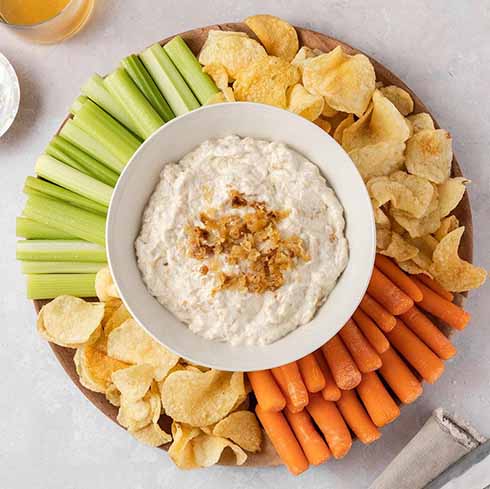
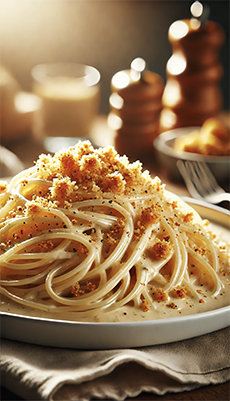
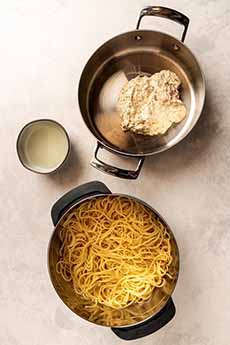
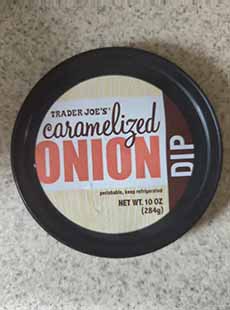
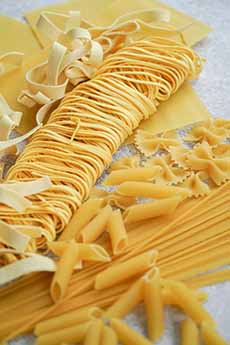

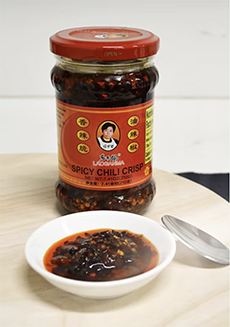
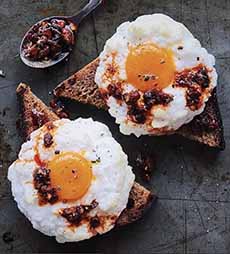

 [9] Lao Gan Ma Noodles with Spicy Chili Crisp
[9] Lao Gan Ma Noodles with Spicy Chili Crisp 